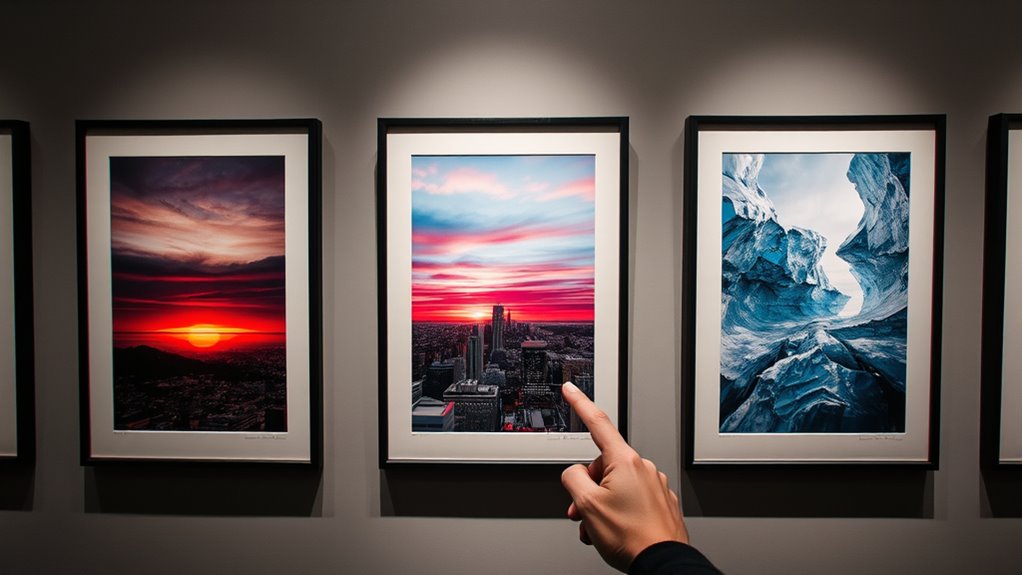The rise of limited-edition photography in contemporary art reflects your growing desire for exclusive, high-quality works that stand out in today’s digital and cultural landscape. Artists and galleries create scarcity through controlled print runs, boosting desirability and value. Technological advances like high-resolution imaging and blockchain authentication enhance authenticity and preservation. Collectors see these works as investments and personal treasures. If you explore further, you’ll discover how these trends are shaping the future of photography as an elite art form.
Key Takeaways
- Cultural shifts and technological innovations have elevated limited-edition photography as a valued artistic medium.
- Scarcity and exclusivity drive demand, making limited editions highly desirable for collectors and investors.
- Advances like blockchain and NFTs ensure authenticity, provenance, and digital uniqueness of limited prints.
- Curated control of supply and strategic presentation enhance the perceived value and prestige of limited editions.
- Strong artist-collector relationships foster loyalty, emotional engagement, and support for limited-edition photographic works.
The Evolution of Photography as a Limited-Edition Art Form
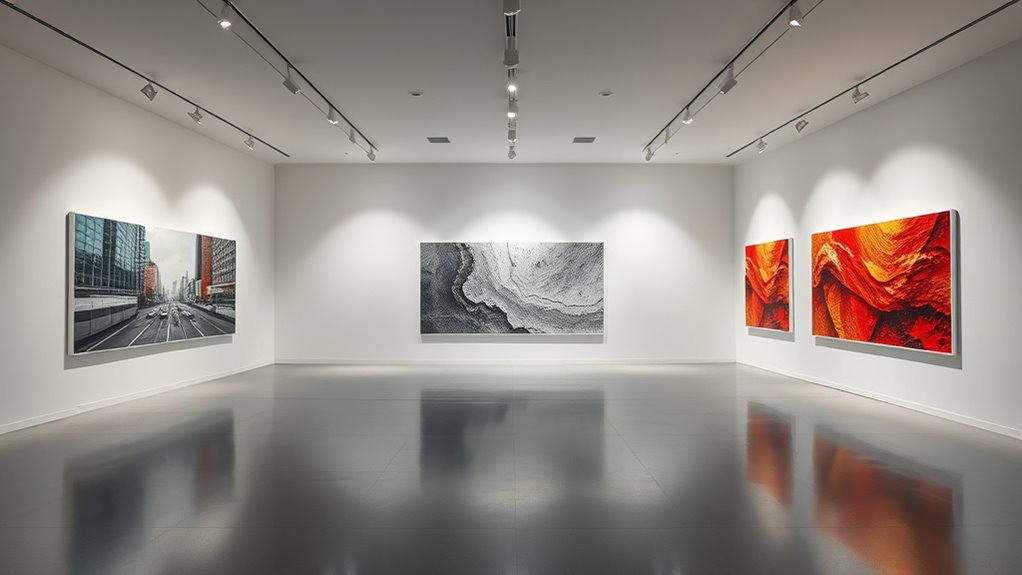
The evolution of photography as a limited-edition art form reflects both technological advancements and shifting collector preferences. Historically, photography shifted from simple documentation to a respected artistic medium, influenced by cultural shifts and artistic movements. Early photographers experimented with print techniques, elevating photography’s status and making limited editions more desirable. Cultural influences, such as the rise of modernism or digital innovation, shaped how artists and collectors viewed exclusivity and value. Limited editions emerged as a way to preserve rarity and authenticity, aligning with broader art world trends. As technology improved, artists gained new tools to produce high-quality, unique prints. Today, this history underscores the importance of exclusivity and cultural relevance, making limited-edition photography a essential part of contemporary art collections. Additionally, collector preferences continue to evolve as new generations seek distinctive and meaningful artworks.
Key Factors Driving the Popularity of Limited Editions
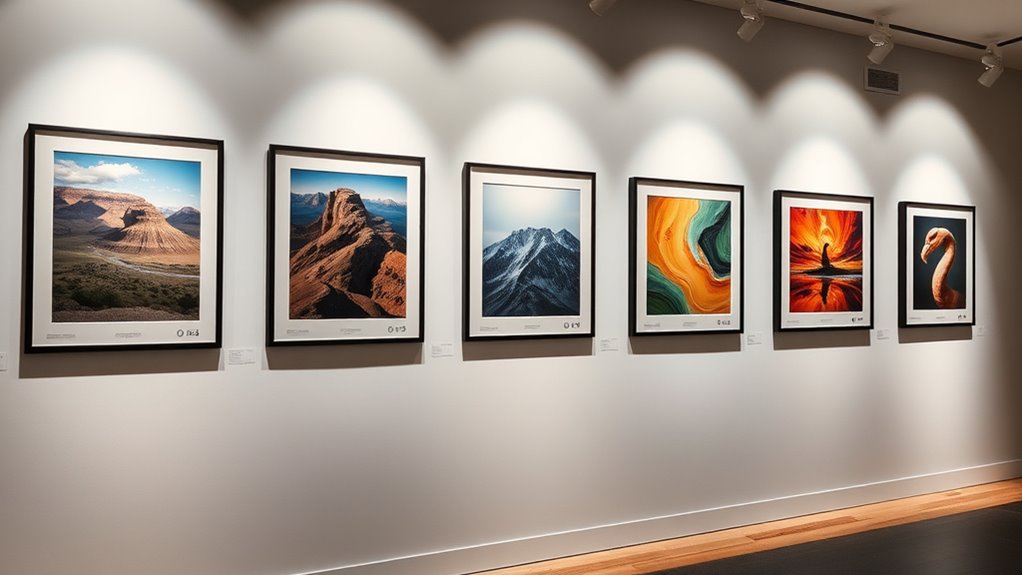
You’ll notice that scarcity and exclusivity make limited editions highly desirable. The strong relationship between artists and collectors also fuels their appeal, as it creates a sense of connection and trust. Additionally, many see limited editions as smart investments, as their value often appreciates over time. With the rise of AI-driven tools for content creation, some artists are exploring how generative AI can produce unique and innovative pieces, further influencing the perception of exclusivity in contemporary art.
Scarcity and Exclusivity
Why do collectors and art enthusiasts flock to limited-edition photographs? The answer lies in scarcity and exclusivity. When a photograph is produced in limited quantities, it instantly becomes more desirable because owning it feels special and rare. This sense of exclusivity drives up value and appeal. Artists leverage social media marketing to highlight the limited nature of their work, creating buzz and urgency. Attending photography workshops can deepen your understanding of an artist’s intent, making the limited edition even more meaningful. The combination of limited availability and strong marketing makes these photographs highly sought after. As a result, collectors see limited editions as investments and status symbols, fueling their desire to acquire exclusive pieces that stand out. Utilizing professional marketing techniques and understanding current industry trends can further enhance the visibility and desirability of limited-edition photographs.
Artist-Collector Relationship
Artists often cultivate strong relationships with collectors by creating limited-edition photographs that foster a sense of intimacy and exclusivity. This approach aligns with collector motivation, as buyers seek personal connections and unique pieces. By engaging in artist collaboration, you deepen the bond, making the collector feel like a partner in the creative process. This mutual involvement enhances loyalty and trust. The following table highlights key aspects of this relationship:
| Aspect | Impact |
|---|---|
| Collector Motivation | Drives demand for unique, meaningful works |
| Artist Collaboration | Builds trust and personal connection between artist and collector |
| Exclusivity | Reinforces collector’s sense of privilege |
| Personal Involvement | Encourages collectors to feel invested in the art process |
| Long-term Relationships | Fosters ongoing support and future acquisitions |
Additionally, embracing emotional impact in the presentation of limited editions can deepen the emotional connection between the artist and collector, further strengthening the relationship.
Investment and Value
The rising popularity of limited-edition photographs in contemporary art is driven largely by their investment potential and inherent value. These works often see strong market valuation, making them attractive to collectors seeking profitable assets. Limited editions create scarcity, which can drive up prices over time, especially as demand increases. Smart investment strategies involve understanding artists’ trajectories and the rarity of specific editions. You can boost your portfolio by acquiring pieces with high perceived value and staying informed about market trends. Limited editions tend to appreciate more reliably than open editions, offering a tangible asset to hold or resell. Additionally, the limited-edition nature of these works often enhances their desirability and exclusivity, further contributing to their value. Overall, their combination of exclusivity and potential for appreciation makes them a compelling choice for both art enthusiasts and savvy investors.
How Artists and Galleries Create Scarcity and Value
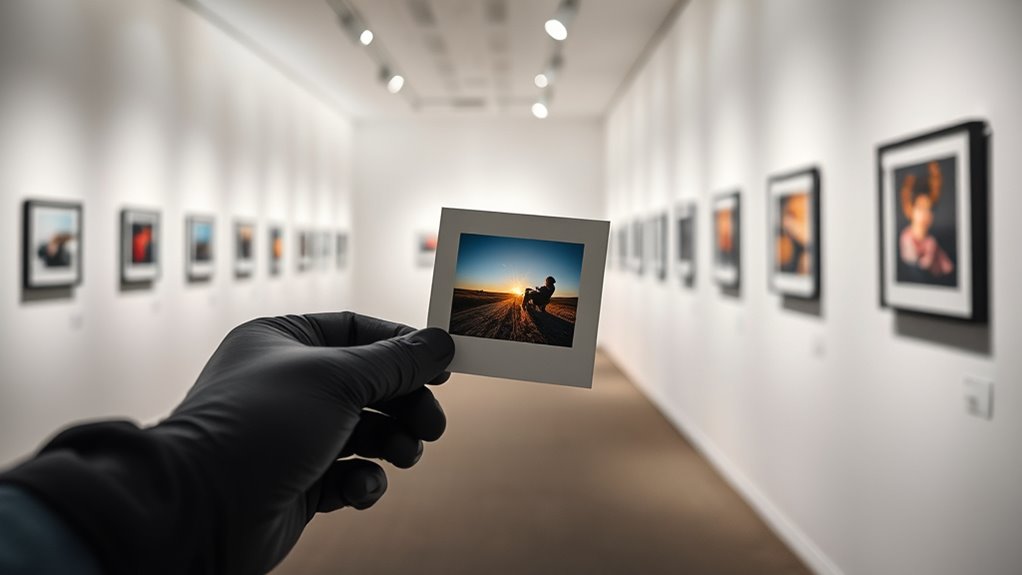
Ever wonder how galleries and artists turn limited-edition photography into highly sought-after collectibles? They do this by carefully controlling supply, creating a sense of exclusivity that counters market saturation. Limiting the number of prints enhances each piece’s rarity, making it more desirable for collectors. Artists often embed cultural significance into their work, connecting it to current social themes or historical moments, which boosts its value. Galleries strategically release these editions at key times, using branding and storytelling to elevate the artwork’s prestige. This combination of scarcity, cultural relevance, and expert marketing builds demand and justifies higher prices. Incorporating track development techniques in their promotional strategies can further amplify the perceived value of these limited editions. As a result, limited-edition photography becomes not just art, but a coveted symbol of status and cultural importance.
The Impact of Technology on Limited-Edition Printing

Advancements in digital printing let artists produce limited editions with incredible detail and accuracy. Blockchain authentication now guarantees the provenance and scarcity of each piece, giving collectors more confidence. High-resolution imaging techniques further enhance image quality, making limited editions more desirable and verifiable. Proper printing techniques ensure the longevity and fidelity of each limited edition art piece.
Digital Printing Advancements
Digital printing technology has revolutionized how limited-edition photographs are produced, allowing you to achieve unprecedented levels of detail and color accuracy. Advanced printers use a wider color gamut, capturing subtle nuances that make images more vibrant and true to life. This means your artwork maintains its integrity over time, thanks to improved print durability that resists fading and environmental damage. You can confidently offer collectors pieces that remain visually stunning for decades. Additionally, innovations in ink formulations and paper compatibility enhance longevity without sacrificing quality. As a result, digital printing empowers you to create limited editions that are both visually compelling and resilient, elevating their value and appeal in the contemporary art landscape. Furthermore, understanding print durability and how it impacts long-term preservation can help you make informed decisions about material selection and display.
Blockchain Authentication Methods
Blockchain authentication methods are transforming how limited-edition photographs are verified and protected in the digital age. By leveraging blockchain verification, artists and collectors can guarantee the authenticity and provenance of each piece. NFT integration plays an essential role here, allowing limited-edition prints to be tokenized as unique digital assets. When you own a photograph with blockchain-backed verification, you gain a transparent, tamper-proof record of its origin and edition size. This technology reduces forgery risks and enhances trust in the art market. As a result, artists can confidently issue limited editions, knowing their work’s authenticity is securely documented. Increased thickness of protective layers in digital verification methods can further improve the durability of blockchain records. Blockchain authentication methods are reshaping the landscape, making limited-edition photography more secure, transparent, and valuable for creators and collectors alike.
High-Resolution Imaging Techniques
High-resolution imaging techniques have revolutionized the way limited-edition photographs are created and reproduced, allowing you to capture intricate details with unmatched clarity. By leveraging advanced image resolution, you can produce images that reveal fine textures and subtle nuances, enhancing the artwork’s impact. Precise color calibration ensures that colors remain true to the original, preserving the artist’s vision across prints. These technologies enable you to achieve consistent quality, making each limited-edition piece unique and highly valued. As a result, collectors and enthusiasts can appreciate the depth and vibrancy of every photograph. Implementing regular maintenance practices ensures that imaging equipment consistently produces optimal results. High-resolution imaging not only elevates the visual fidelity of limited editions but also reinforces their authenticity and exclusivity in the contemporary art market.
Collectors’ Perspectives on Owning Limited-Edition Works

Many collectors see owning limited-edition photographs as a way to acquire unique, tangible art that holds both aesthetic and investment value. Their collector motivations often stem from a desire for exclusivity and a connection to the artist’s vision. Ownership experiences are deeply personal; owning a limited-edition piece feels like possessing a rare moment captured in time. It offers a sense of pride, knowing you have a work that’s not widely available. The scarcity enhances its desirability, and many collectors appreciate the craftsmanship behind limited editions. For them, owning such works isn’t just about aesthetics but also about supporting artists and investing in art that can appreciate over time. This combination of emotional and financial factors makes limited-edition photography especially appealing. Additionally, understanding the emotional support aspects of art collecting can deepen the personal connection and fulfillment derived from owning these exclusive pieces.
Case Studies of Notable Limited-Edition Photography Projects
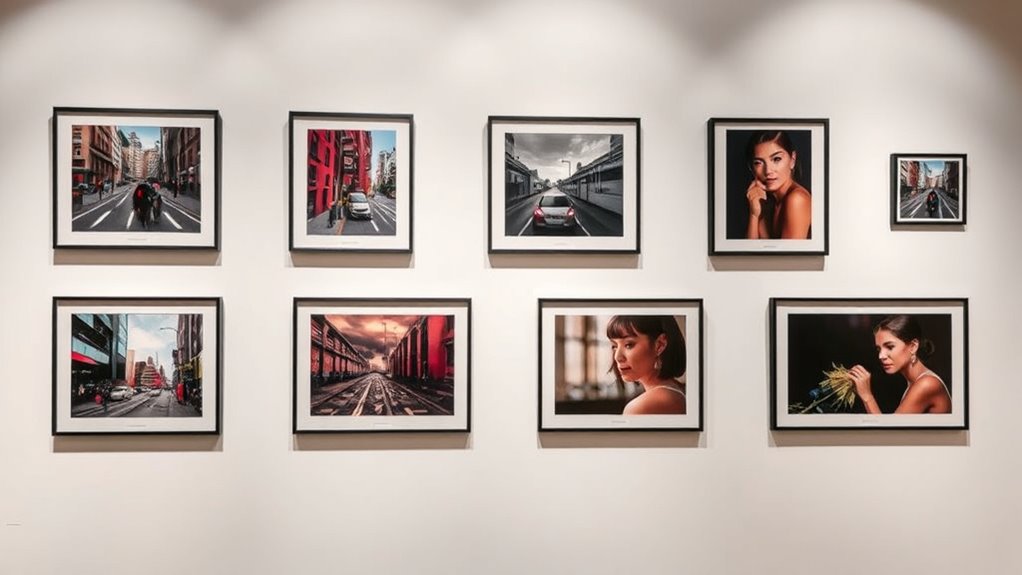
Among the most celebrated limited-edition photography projects are those that have pushed creative boundaries and set new standards for exclusivity. These projects often draw on historical context, reflecting pivotal moments or artistic movements, which add depth and significance. Cultural influences play a crucial role, shaping the themes and visual language of these works, making them resonant across different societies. For example, a limited-edition series capturing the aftermath of historical events can evoke powerful emotions and provide a unique perspective unavailable in mass-produced images. By examining these case studies, you see how artists leverage cultural narratives and historical moments to create iconic, highly sought-after editions. Additionally, the rise of limited-edition photography has been supported by advancements in digital and printing technologies, making it easier for artists to produce high-quality, exclusive works on a smaller scale. These projects not only elevate the medium but also influence collectors and the broader art world.
Challenges and Criticisms Surrounding Limited Editions
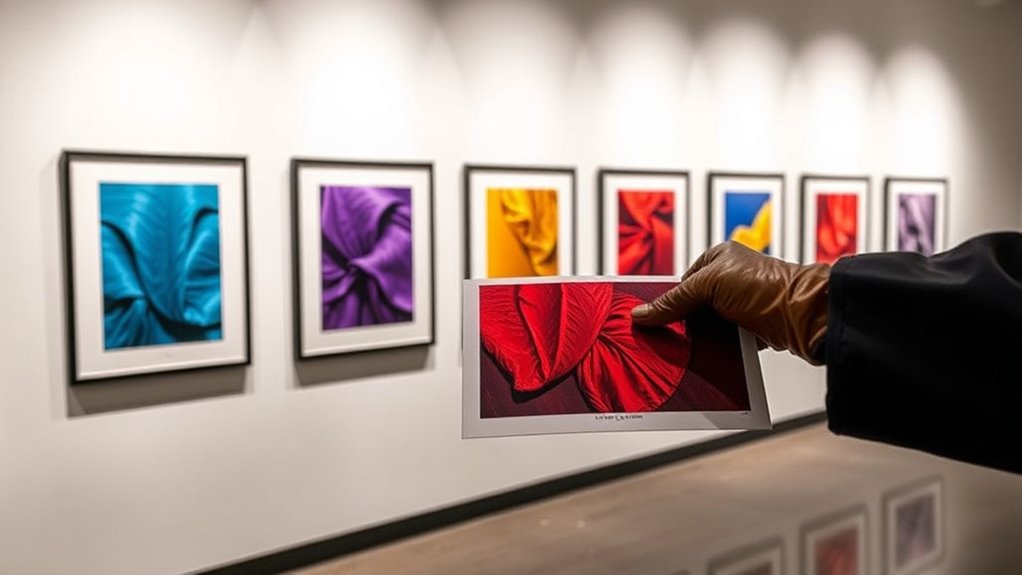
While limited-edition photography projects can elevate the medium and create exclusivity, they also face significant challenges and criticisms. One major issue is authenticity concerns, as collectors and critics question whether limited editions truly preserve the artist’s intent or are manipulated for profit. Market saturation is another problem, with an influx of limited editions diluting their value and making it harder for collectors to distinguish genuine investments from overproduced works. Additionally, some argue that the emphasis on scarcity can prioritize commercial interests over artistic integrity. This environment can lead to skepticism about whether limited editions genuinely benefit the art or simply serve as a marketing strategy. Moreover, the concept of symbolic meaning within limited editions can be misunderstood or exaggerated, further complicating their valuation. As a result, many question if the appeal of limited editions outweighs their potential drawbacks.
The Future of Limited-Edition Photography in the Art Market
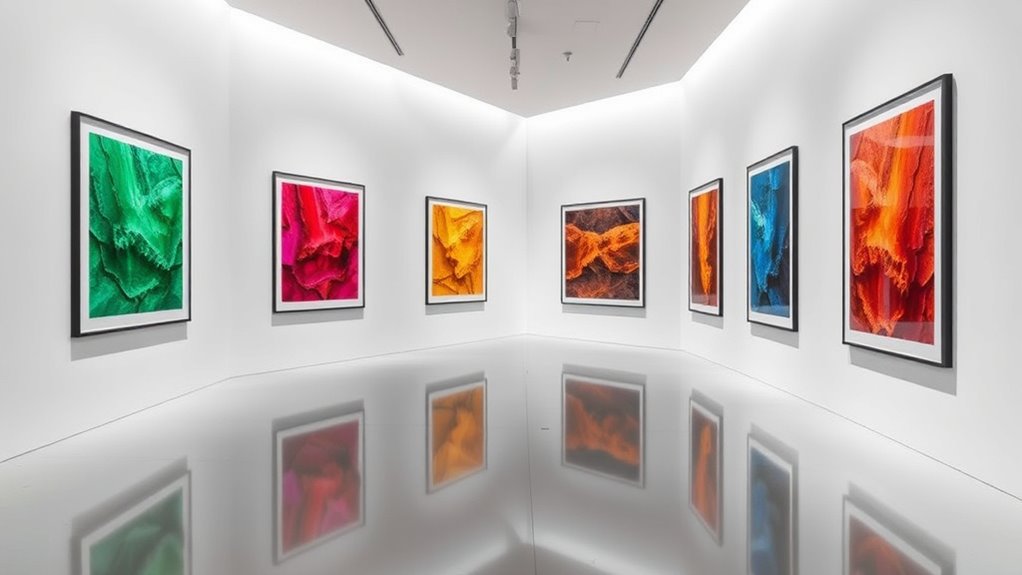
The future of limited‑edition photography in the art market will likely be shaped by evolving technology and shifting collector expectations. Market trends suggest increased digital integration, such as blockchain and NFTs, which may redefine exclusivity and provenance. As collector demographics diversify, you’ll see more younger buyers valuing digital scarcity and transparency. This shift could drive demand for innovative formats and new ways to authenticate limited editions. Additionally, traditional collectors may seek more personalized or interactive experiences, influencing how limited editions are produced and sold. Overall, the market will likely become more dynamic, with technology enabling artists to reach broader audiences while maintaining the allure of rarity. Staying adaptable to these trends will be key for artists and collectors alike in steering the evolving landscape. Furthermore, eco-friendly handmade practices could influence the production and presentation of limited editions, appealing to environmentally conscious consumers.
Strategies for Artists to Successfully Launch Limited Editions
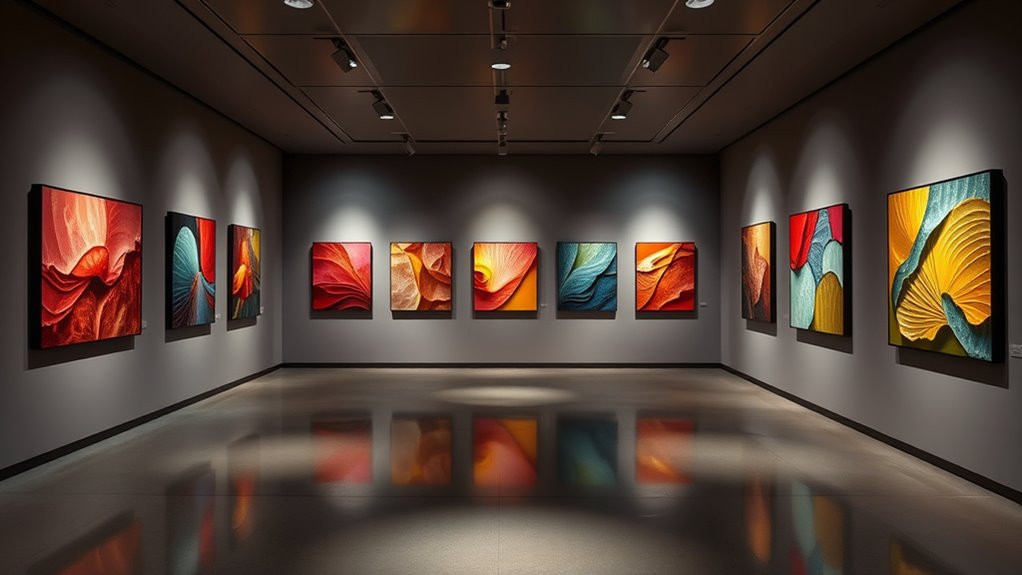
Launching successful limited editions requires strategic planning and a clear understanding of your target audience. Keep an eye on current market trends to determine ideal pricing, edition size, and release timing. Collaborating with other artists can expand your reach and add credibility to your work. Consider the following strategies:
| Strategy | Benefit |
|---|---|
| Research market trends | Aligns your edition with demand |
| Partner with other artists | Enhances credibility and exposure |
| Limit edition size | Creates exclusivity and value |
| Use targeted marketing | Reaches the right collectors |
Additionally, understanding the contrast ratio of your prints can influence how your artwork is perceived under different lighting conditions, ensuring optimal presentation.
Frequently Asked Questions
How Do Limited Editions Influence an Artist’S Overall Career Trajectory?
Limited editions can considerably shape your career, as they boost your market impact by creating exclusivity and demand. This often enhances collector perception, positioning you as a sought-after artist. By offering limited works, you encourage collectors to act quickly, increasing your value and visibility. Ultimately, these editions help you build a strong reputation, attract premium buyers, and open doors for future opportunities in the competitive art world.
What Ethical Considerations Arise From Producing and Selling Limited-Edition Photographs?
When producing and selling limited-edition photographs, you must consider ethical issues like authenticity concerns and consumer transparency. You’re responsible for honestly representing the edition size, ensuring buyers understand what they’re getting. Misleading claims or lack of clear information can harm trust and reputation. By prioritizing transparency and accurately communicating the rarity and value of your work, you uphold ethical standards and foster genuine connections with collectors.
How Does the Global Market Affect the Valuation of Limited-Edition Works?
You should consider how the global market impacts the valuation of limited-edition works through market influence and pricing strategies. When demand rises internationally, prices tend to increase, boosting the work’s perceived value. Conversely, oversupply or weak market interest can lower prices. By understanding these dynamics, you can better navigate pricing strategies, recognizing that global trends and economic shifts directly affect the worth of limited-edition photographs.
Are There Specific Genres Within Photography That Favor Limited Editions More Than Others?
You’d think all photography genres love limited editions equally, but nope. Conceptual photography often thrives in this sphere, turning print editions into coveted treasures. Unlike landscape or portrait work, which might flood the market, conceptual pieces stand out with limited runs, amplifying their mystique and value. So, if you’re eyeing exclusivity, focus on conceptual photography—it’s the genre that truly appreciates the power of limited print editions.
How Do Emerging Technologies Like NFTS Impact Traditional Limited-Edition Photography?
Emerging technologies like NFTs revolutionize traditional limited-edition photography by offering digital ownership and authenticity verification. You can now buy, sell, and trade limited-edition photos securely online, knowing each piece’s provenance is verified. NFTs create a digital scarcity similar to physical editions, but with added convenience and global reach. This shift encourages collectors to see digital art as valuable, transforming how limited editions are perceived and traded in the contemporary scene.
Conclusion
As you explore the world of limited-edition photography, you’ll notice how scarcity and innovation intertwine, shaping its rise in contemporary art. With technology making exclusivity more accessible and collectors craving unique pieces, this trend feels both inevitable and serendipitous. You might find yourself drawn to the stories behind each limited edition, realizing that in this dance of rarity and creativity, the art becomes more than just images—it becomes a personal, treasured experience.
